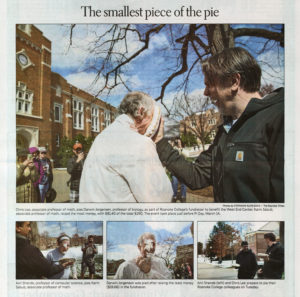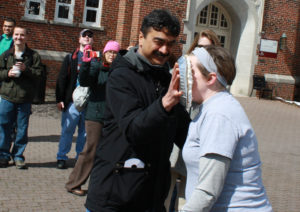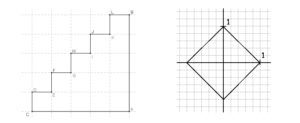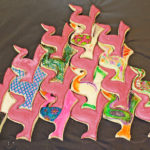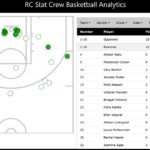Pi Day was served cold this year, with a la snow on the side. The unseasonably cold weather did not deter the Math Club from its celebration of 3/14 and various things mathematical. The Pi-athlon was run with teams of students solving mathematical puzzles for points, with the goal of gaining as close to 100 π = 314.15926 — points as possible. Dr. Chris Lee gave the Pi Day talk on Standard Deviations – Flawed Assumptions, Tortured Data, and Other Ways to Lie with Statistics.
Chris also had an important role in the annual pie-ing of professors. Collection jars were out for students, faculty, and staff to donate money in the name of the professor they would most like to see pied. To add an interesting twist, the professors with the most and least money get pied. Out of the seven good souls who agreed to be in the contest, the “winners” were Dr. Karin Saoub with $81.40 and Dr. Dar Jorgensen with $19.66. A total of $290 was raised for the West End Center in Roanoke. Chris Lee and Anil Shende, both past Pi Day honorees, delivered the pies to their destinations, in time for a nice spread in the Roanoke Times (above).
My calculus class celebrated Pi Day with the following fun fact: π is the smallest possible value for pi. Here is what is meant by this bizarre statement. Define pi to be the circumference of a circle divided by its diameter. Both “circumference” and “diameter” depend on how we measure distance, and mathematicians have numerous ways of doing so. The value π = 3.1415926 — is what we get for pi using the usual distance formula. Other distance formulas produce larger values for pi.
For example, what is sometimes called the “taxicab metric” defines the difference between points (a,b) and (c,d) to be |a-c|+(b-d|. A cab going from (0,0) to (5,5) could not go directly to (5,5) if there were buildings in the way. It could drive 5 blocks east and then 5 blocks north, a total distance of 10 blocks (or, as shown, 1 block north, then 1 block east, and so on, for a different route of the same distance of 10 blocks). In this metric, a “circle” (the set of all points equidistant from the center, so the measurement method matters) is a diamond and the ratio of the circumference to diameter is 4.
The result that π is the smallest possible value for pi, published by Adler and Tanton in the March 2000 issue of College Mathematics Journal, shows that the pi we serve you in basic math classes is the best pi you will ever get!
